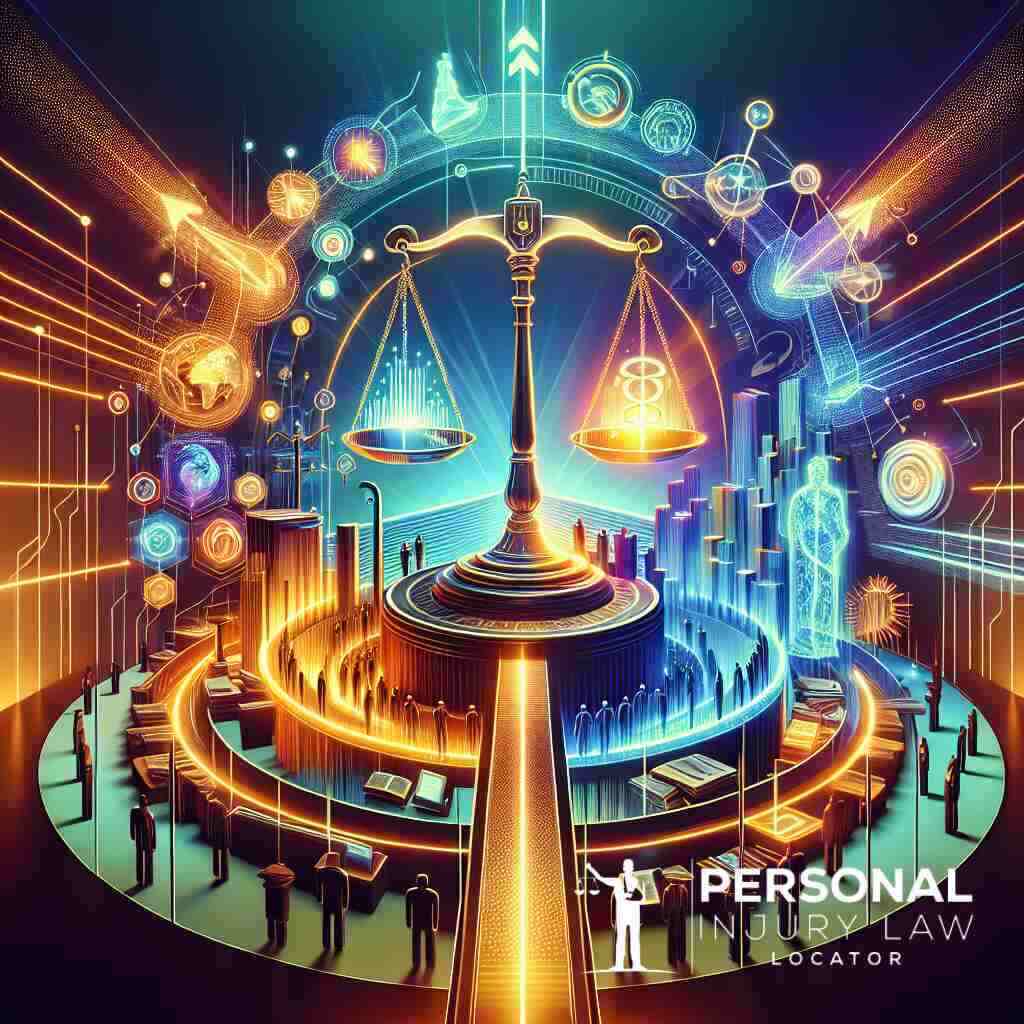 Posted On: 05/09/2025
Posted On: 05/09/2025Introduction: Navigating the Legal Labyrinth
Understanding the Proliferation of Personal Injury Cases
In today’s fast-paced world, personal injury cases are reaching unprecedented levels. With our daily lives intertwined with complex technologies, vehicles, and various public spaces, the frequency of car accidents and other personal injuries is on the rise. This upward trend necessitates an acute understanding of personal injury law and access to resources like Personal Injury Law Locator. As people seek justice and compensation for their injuries, navigating these legal processes has become more intricate and demanding than ever before.
The Role of Personal Injury Law Locator in Modern Claims
The Personal Injury Law Locator plays an essential role in seamlessly connecting individuals with the right personal injury lawyers to handle their specific cases. For those affected, finding competent legal representation is paramount in ensuring a robust advocacy process. The sophisticated platform provides access to seasoned legal professionals across all 50 states, ensuring that the injured party receives precise legal guidance tailored to their jurisdiction. This powerful network streamlines the personal injury claim process, leading to more favorable settlements and verdicts for clients across the nation.
Setting the Stage: Legal Compensation and State-Specific Dynamics
Legal compensation differs significantly from one state to another due to varying statutes and jurisprudence. Understanding these nuances is critical for anyone involved in a personal injury claim. Factors such as fault determination, damage caps, and specific state laws play crucial roles in shaping the outcomes of personal injury cases. Familiarity with tools like the Comparative Analysis of Injury Laws can offer a more in-depth understanding of how legal landscapes vary and the possible complexities in pursuing accident compensation. This comprehensive understanding allows claimants to navigate the maze of legal liability with informed confidence, ensuring that their pursuit of justice is both strategic and informed.
Unraveling the Intricacies of Personal Injury Claims
Decoding the Injury Claim Process
To successfully navigate a personal injury claim, it’s imperative to grasp the intricacies of the injury claim process. The initial step involves gathering evidence related to the incident, which is crucial for substantiating the claim. This includes medical records, eyewitness accounts, and any available video footage. An essential aspect is ensuring all documentation is meticulously organized, paving the way for a persuasive narrative. Subsequently, claimants engage with insurance companies, presenting their case for compensation. A thorough understanding of insurance claim negotiations is vital, as the negotiation phase can be particularly challenging and determinative of the overall outcome.
Hiring a skilled personal injury lawyer is another critical step in this process. The expertise of a legal professional can be invaluable in dealing with the complexities of legal processes, including filing the lawsuit, representing the injured party in court, and ensuring every aspect of the case is handled strategically. The support of competent legal representation also mitigates the risk of overlooking critical deadlines or filing requirements, ensuring a smooth progression through legal procedures.
Categories of Personal Injuries: From Minor to Complex
Personal injury claims encompass a wide array of scenarios, each with its unique implications on the legal process. Minor injuries, such as whiplash or sprains encountered in car accidents, might only require straightforward claims for minor compensation. However, more severe injuries, like traumatic brain injuries or significant burns, fall under complex personal injuries that necessitate a detailed approach.
A comprehensive understanding of injury categories is crucial for determining the nature of the claim and the potential compensation involved. Advanced cases may involve multiple parties, including medical professionals for expert testimony, heightening the complexity. Different injury categories also impact the strategy for pursuing claims, with varying tactics needed to secure favorable outcomes. For instance, workplace injuries may require navigating through employment laws and workers’ compensation claims in addition to personal injury statutes.
Navigating the Maze of Legal Liability and Insurance Policies
Understanding legal liability is a cornerstone for any personal injury claim. Legal liability determines the party or parties responsible for causing harm, guiding the liability determination process. Understanding legal liability ensures that the right entities are held accountable in personal injury claims, be it individuals, businesses, or insurance companies. Each case’s specifics profoundly influence these legal assessments, with negligence often playing a pivotal role.
Equally important is comprehending the role of insurance policies in this dynamic. Insurance coverage can significantly affect both the claim’s scope and the strategy employed. Policies vary widely in terms of coverage limits and exclusions, demanding a nuanced approach to each case. Familiarity with terms and conditions within insurance policies enables a more informed and strategic pursuit of claims, enhancing the likelihood of securing deserved compensation for the injured party.
Claim Evaluation: Weighing Damages Against Medical Bills
Evaluating a personal injury claim involves meticulously balancing the estimated damages against incurred medical bills. This claim evaluation process requires a detailed analysis of tangible and intangible damages sustained by the injured person. Compensation is not solely confined to medical treatment expenses; it may also encompass lost wages, property damage, physical suffering, and emotional distress.
An effective claim evaluation thoroughly assesses both economic and non-economic damages. The process requires substantiating claims with documented evidence, which may include medical reports and financial statements indicating lost earnings. Engaging with seasoned personal injury lawyers ensures claimants receive a comprehensive assessment of their claims’ potential value, considering both current and future repercussions. An accurate evaluation is instrumental in formulating a successful strategy for securing adequate compensation from the responsible party or their insurance provider.
The complexities of personal injury claims demand astute navigation and expert guidance at every step. From understanding the intricate legal frameworks to strategically managing negotiations with insurance companies, a well-informed approach is the key to achieving just compensation. Leveraging resources like the Guide to injury litigation strategies empowers claimants with knowledge and confidence, enabling them to tackle these multifaceted challenges successfully.
Strategic Approaches to Claim Negotiation and Settlements
The Art of Negotiation with Insurance Companies
Negotiating with insurance companies requires finesse and a sound understanding of personal injury claims. Successful negotiation is a calculated endeavor in which the injured person effectively conveys the full extent of their losses and injuries. Personal injury attorneys utilize their comprehensive expertise of policies and claims to ensure that none of their clients’ rightful compensation is left on the table. The ability to highlight relevant case law and precedents can significantly enhance the negotiation process, fostering an environment conducive to favorable outcomes.
Timing is another pivotal element within these negotiations. Legal representatives strategically decide when to press for settlements, taking into account the ebb and flow of the claims process. By thoroughly understanding the dynamics between insurance adjusters and the legal intricacies of personal liability, attorneys optimize outcomes for the injured parties. Given these complex scenarios, the role of insurance in injury cases is crucial for both establishing liability and understanding policy-driven constraints.
Settlement Strategies: Beyond the Courtroom
Exploring settlement strategies that extend beyond the courtroom involves intense strategizing and foresight. While courtroom battles can be arduous, settlements often offer a more expedient and definitive pathway to compensation. In many cases, personal injury lawyers employ alternative dispute resolution methods to expedite clients’ compensation. Mediation and arbitration are routinely utilized in efforts to resolve disputes without escalating to protracted litigation.
Structured settlements can be particularly advantageous in minimizing tax liabilities and ensuring long-term financial security for the injured. By tailoring settlements to the specific needs and future circumstances of the injured party, attorneys ensure a stable financial future. Understanding the benefits and nuances of structured settlements in injury cases is vital for crafting settlements that align with the client’s best interests, complementing a broader resolution strategy.
Legal Team Dynamics: Crafting a Robust Litigation Strategy
A well-coordinated legal team can be the linchpin in crafting effective litigation strategies that drive successful personal injury claims. This dynamic involves careful coordination of legal tasks, leveraging each team member’s expertise in the injury claim process effectively. A sophisticated approach to litigation ensures that every aspect of the claim is meticulously handled, leading to more comprehensive representation.
Developing a robust litigation strategy necessitates a deep dive into the injury case dynamics, examining both the personal and legal facets. Legal teams often analyze case law, jurisdictional statutes, and client-specific factors to tailor strategies that maximize compensation. The importance of teamwork is underscored in high-stakes cases involving complex personal injuries, where collective expertise can mean the difference between success and failure.
Moreover, the integrity of documented evidence and the employment of expert witnesses can bolster litigation pursuits. An adept legal team takes into account every minute detail of the personal injury lawsuit, ensuring meticulous preparation. Legal advocacy forms the bedrock of a compelling case narrative, thereby affirmatively influencing outcomes in court settlements and beyond.
For those navigating this intricate domain, Personal injury lawyers near me can provide immediate assistance and local expertise, ensuring that legal proceedings are both informed and strategically sound.
The Pivotal Role of Legal Advocacy and Representation
Choosing the Right Personal Injury Attorney: Factors to Consider
Choosing the right personal injury attorney is pivotal in achieving successful outcomes in personal injury cases. An attorney’s experience, particularly in handling cases akin to yours, is fundamental. It’s crucial to assess their track record in securing favorable verdicts and settlements, as they offer a glimpse into their negotiation prowess with insurance companies. Additionally, understanding Personal injury lawyer requirements is essential in evaluating a lawyer’s qualifications. Client testimonials and reviews can also provide valuable insights into an attorney’s effectiveness in real-world situations. Furthermore, ensuring that an attorney exhibits an empathetic approach toward their clients significantly enhances the advocacy process, as emotional distress plays a substantial role in personal injury lawsuits.
Accessibility is another vital consideration when selecting a personal injury attorney. Ideally, an attorney should be readily available to provide ongoing updates and consultations, demonstrating a commitment to your case. The legal complexities of personal injury claims require a lawyer who not only understands negligence and injury claims but can also explain these intricacies in layman’s terms. By choosing a lawyer well-versed in both local and national personal injury trends, clients enhance their chances of navigating the legal labyrinth effectively and conclusively securing fair compensation.
The Power of Documentation: Building an Irrefutable Case
Building a compelling personal injury case necessitates meticulous documentation, which serves as the backbone of the claims process. Documentation establishes a narrative that illustrates the sequence of events leading to the injury and its subsequent impacts on the injured party. Medical records, police reports, and eyewitness testimonies form the cornerstone of compelling personal damage claims. The effectiveness of Understanding injury claims in 2025 hinges on presenting well-documented evidence.
Effective documentation extends beyond just physical records. Employing expert witnesses and gathering photographic or video evidence can significantly strengthen a case. Accurate data collection ensures that the reality of the physical injuries and emotional distress suffered is clearly communicated. Evidence of financial losses, such as medical bills and loss of income, also plays a pivotal role in substantiating claims for compensation. By leveraging a comprehensive suite of documentation, legal representatives craft a robust narrative that convincingly argues the merits of the personal injury claim, initiating discussions on settlement terms or courtroom strategies with reinforced credibility.
State-Specific Laws: How Jurisdiction Affects Your Claim
Understanding state-specific laws is imperative in any personal injury claim, as jurisdiction profoundly affects the legal process and potential outcomes. Each state provides distinct frameworks for compensation, liability, and procedural requirements. For instance, in Injury compensation processes in Florida, no-fault automobile insurance laws significantly influence personal injury settlements. Recognizing these jurisdictional nuances ensures compliance with legal statutes, fostering smoother claim manage,ent, and avoiding procedural pitfalls.
The variability in state laws underscores the importance of selecting a personal injury lawyer with localized expertise. Attorneys knowledgeable about state-specific nuances harness these insightsto navigate personal injury claims strategicallys. For example, understanding injury cases in Texas requires an understanding of Texas’s comparative negligence rules, which may influence compensation amounts based on plaintiff fault percentages. By aligning their expertise with state regulations, legal teams enhance the prospects for fair compensation, ensuring unfamiliar legal landscapes do not inadvertently disadvantage claimants.
Conclusion: Charting the Course Toward Fair Compensation
Bridging the Gap: From Emotional Distress to Legal Resolution
Personal injury claims often involve significant emotional distress for the injured party. The psychological ramifications of an accident can ripple through every aspect of life, complicating the pursuit of justice. Legal resolution in injury lawsuits seeks to bridge this gap by addressing both tangible and intangible damages. Recognizing the significance of emotional distress in injury lawsuits introduces a multifaceted perspective to personal injury claims. This approach not only aids in securing financial compensation but also provides a sense of closure. Understanding this dynamic is essential for legal representatives aiming to validate the complexities of these claims comprehensively.
A dual focus is crucial when contemplating these resolutions. While financial settlements address economic damages and medical bills, emotional relief is equally pertinent. The role of a skilled personal injury lawyer is to tactfully intertwine emotional narratives within the broader context of legal action. This procedure ensures that claimants feel fully represented and that their suffering is given due recognition in settlement discussions or court.
The Continuous Evolution of Personal Injury Law
The domain of personal injury law is constantly evolving, shaped by new precedents, technological advancements, and society’s changing dynamics. Understanding current trends is key to navigating these waters effectively. As legal frameworks adapt, so do the strategies and approaches lawyers use to secure favorable outcomes for their clients. Awareness of blogs on injury law trends highlights the shifts in injury litigation, from emerging technological considerations in car accidents to evolving standards of negligence.
Lawyers and claimants must remain abreast of these changes to ensure compliance with the latest legal standards. This adaptability enables them to leverage new legal precedents or legislation in favor of claimants. Continuous learning and flexibility in strategy are pivotal for legal teams hoping to stay ahead of the curve. Engaging with current injury law trends fosters a proactive approach in developing litigation strategies, empowering both lawyers and clients in their pursuit of justice.
How Personal Injury Law Locator Transforms the Legal Landscape
In the vast terrain of personal injury law, securing expert legal representation is paramount. Personal Injury Law Locator has revolutionized access to legal advocacy by bridging the gap between injured individuals and seasoned personal injury attorneys nationwide. This platform enables individuals to connect swiftly with Personal injury lawyers in New York or find experts in California or any other state, significantly streamlining the resource discovery process.
Through its comprehensive database, Personal Injury Law Locator provides an invaluable service, particularly for those unfamiliar with navigating the complexities of legal proceedings. The easy-to-use platform grants access to vetted professionals equipped to handle varying case complexities. By transforming the way victims access legal services, Personal Injury Law Locator ensures tailored legal representation that addresses both state-specific dynamics and individual client needs.
Ultimately, leveraging platforms like Personal Injury Law Locator empowers claimants to chart a well-informed course toward fair compensation. These powerful connections between clients and legal professionals not only enhance case outcomes but also foster a legal environment focused on justice and accountability.
Frequently Asked Questions
Question: How can Personal Injury Law Locator help navigate the complexities of personal injury claims, as discussed in the blog ‘The Complex Dynamics of Personal Injury Claims Today‘?
Answer: Personal Injury Law Locator serves as a crucial platform for individuals dealing with personal injury claims by connecting them with the best personal injury attorneys nationwide. Our service simplifies finding legal representation, especially when facing the intricate legal compensation landscape, nuanced insurance claim processes, and varying state-specific laws. By ensuring access to seasoned personal injury lawyers, clients can confidently pursue their rights to compensation for various personal injuries and ensure proper claim negotiation and settlement strategies.
Question: What role does Personal Injury Law Locator play in ensuring successful negotiation strategies with insurance companies? Read more here.
Answer: Personal Injury Law Locator connects clients with personal injury lawyers who excel in negotiating with insurance companies. These attorneys bring a profound understanding of legal liability and structured settlements, ensuring that the injured person receives rightful compensation. By aligning clients with legal experts who know the nuances of injury claims and personal injury settlements, we enhance the likelihood of achieving favorable outcomes, both in and out of court settlements.
Question: Why is understanding state-specific laws important,,t and how does Personal Injury Law Locator assist with this? Ultimate Guide.
Answer: Each state in the US has unique laws that can significantly impact a personal injury case. Personal Injury Law Locator helps clients navigate this complex landscape by connecting them with local personal injury attorneys who intimately understand jurisdiction-specific legal frameworks. This ensures that personal injury claims are handled with consideration of state-specific dynamics, optimizing the chances for fair compensation and avoiding procedural pitfalls.
Question: How does Personal Injury Law Locator manage the personal injury claim process from initial documentation to final settlement?
Answer: Personal Injury Law Locator guides clients through each phase of the personal injury claim process. We connect clients with attorneys who meticulously gather and organize injury claim documentation, evaluate damage,s including medical bills and property damage, and craft a compelling narrative for negotiation and legal advocacy. By overseeing the litigation strategy, we ensure that each case is approached effectively, from determining liability to finalizing settlements, thereby securing deserved compensation and alleviating emotional distress.
Question: How can Personal Injury Law Locator help individuals dealing with severe and complex personal injuries?
Answer: For complex personal injury cases, such as traumatic brain injuries or wrongful death, Personal Injury Law Locator provides access to specialized legal professionals with extensive experience in managinhigh-stakeske injury case dynamics. Learn more about wrongful death here. Our attorneys comprehensively assess personal damage claims, leveraging expert testimony and state-specific knowledge to support claims for comprehensive compensation. This form of personal claim representation ensures that every aspect of the injury is addressed, enhancing the overall outcome and securing justice for the injured party.




